Five pound sharpening kit
- Thread starter British Red
- Start date
-
Come along to the amazing Summer Moot (21st July - 2nd August), a festival of bushcrafting and camping in a beautiful woodland PLEASE CLICK HERE for more information.
You are using an out of date browser. It may not display this or other websites correctly.
You should upgrade or use an alternative browser.
You should upgrade or use an alternative browser.
Ok I give up I cannot seem to get a very sharp edge on my CC companion I've put an convex edge on but I just can't get it sharp it definitely won't cut paper !!!!!😠 I've tried different techniques after seeing a Ben or ford vid and various YouTube vids but it don't seem to work for me.........heeeeelp!!
Sent from somewhere?
Sent from somewhere?
Yep just a bit frustrating when your trying to get something sharp and just doesn't seem to be happening for you/me
Sent from somewhere?
Hi,
I was under the impression that the whole ray mears standard of cutting paper only really applies to scandi ground, or near scandi ground- knives... Different bevels have different pros and cons, that being the scandi grind has more 'bite' whereas the convex grind is more durable, and is less likely to nick however has less bite...
All the best, Lewis
Well that might explain something thanks Lewis. however it doesn't seem sharp enough or wrong angle possibly to even bite into some easy wood to make feather sticks or am I expecting to much from knife and or the grind??
Sent from somewhere?
Sent from somewhere?
Looks like you're having trouble with a 'rolling' edge, happens from time to time, try to apply more pressure and keep the bevel on the sharpening-surface while going back and forth with it (about 40 times). This will aggressively take of some metal that is still in the way. After this go through the whole process that was explained in the beginning of this thread. Good luck!
Well that might explain something thanks Lewis. however it doesn't seem sharp enough or wrong angle possibly to even bite into some easy wood to make feather sticks or am I expecting to much from knife and or the grind??
Sent from somewhere?
We always take a file for sharpening axes and knifes. For fine sharpening such as knives we find fine stone. In some zreas where we hunt there are traditional knife/axe sharpening sites. I'm in the Uk at the moment and there's plenty of fine stone in the pennines - north yorkshire. I'd take some home if baggage allowance wasn't so poor.
Dc4, o.8mm thick leather glued onto a piece of 1 inch ply and autosol metal polishing compound = razor sharpness, the reason for the thin leather as many people on here will know that thick leather will convex a flat bevel
Making your tools
Now, if you have £30-£40 to invest in a set of water stones, plus £20 for a razor strop and £20 for a great chef steel, you can get a razor edge on your knife. I do mean shaving sharp. But what if you havent? Well a friend of mine challenged me to get a beaten up Mora to shave for under five pounds. I do love a challenge!
I openly acknowledge that all the ideas shown here have been robbed from a variety of sources - not least Mors Kochanski, however a personal experience may be interesting (and the techiques do work) so heres how I went about it. Total cost to me? About £4 max.
You will need ..
Three FLAT pieces of wood around 9 by 4. Actually anything very flat that you can cut to about that size is great tiles work well, thick glass is fantastic, sheet metal, whatever)
A pack of mixed grade wet & dry paper from the local DIY store (240, 400 & 600 grit or close)
A pair of scissors
A piece of old inner tube from your firelighting kit (or a bit of old leather or cork or anything non slip)
Some glue
Some double sided tape (carpet laying tape from the same DIY store is great)

Step 1
Cut your boards to size. They need to be the as long as the width of your wet&dry and about 4 wide. You will need 3 of them
Step 2
Cut a piece of your first wet&dry to fit your board
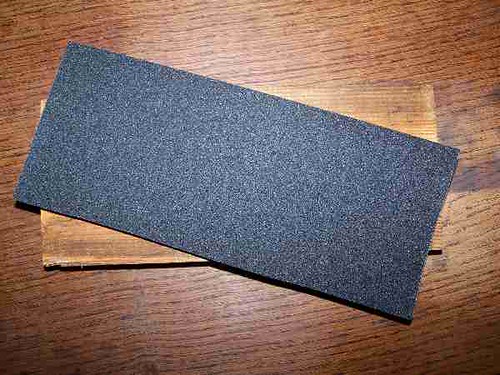
Step 3
Cover the flattest side of the board in double-sided tape
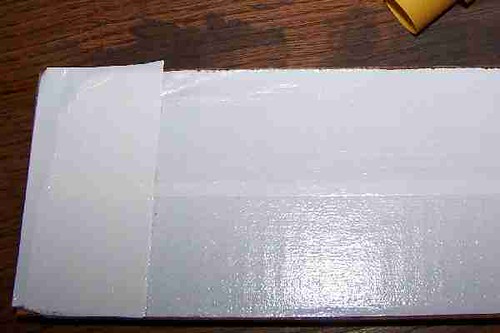
Step 4
Stick the wet&dry onto the tape. Turn over and press flat
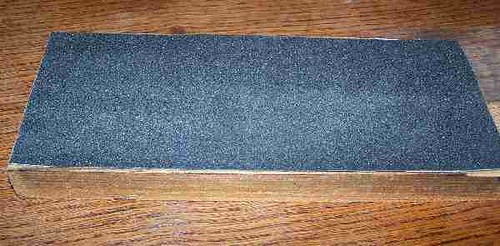
Step 5
Cut up a bit of inner tube to make non slip feet for your board. Glue into place. Using a permanent marker, write the grit size on your board.

Step 6
Repeat for the other grit sizes
You now have a matched set of 3 sharpening boards!
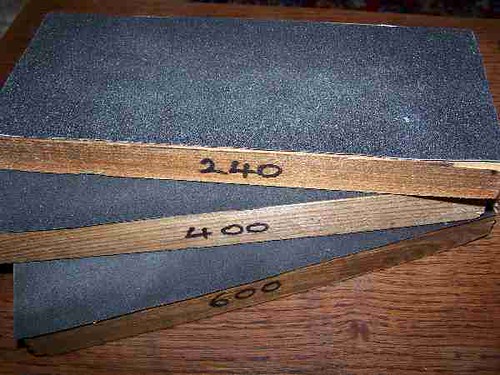
Basic Honing
Now, looking at the knife Im teaching you to sharpen (A Frost Mora), you will notice that it only has a primary grind, and no secondary bevel. This makes it a great bush knife as sharpening is relatively simple even in the field.
So, lets get a working edge.
Step 1
Examine the cutting edge. Are there any nicks or dings in the edge? If so, we need to get rid of them. We do this by placing a metal file flat to the bevel and filing the bevel, for the full length of the blade. Use five strokes on one side followed by five on the other. As the ding disappears, reduce the number until you are alternating sides. As soon as you have a nice straight edge, stop.
Step 2
Take your 240 grit sharpening board. You dont need to wet it. Lay the flat side of the knife flat on the board. Hold the handle of the knife in your right hand and push the hilt up to the board. Using your left hand, spread your fingers and brace the blade evenly across the board.
Here is the angle

Here is what it looks like
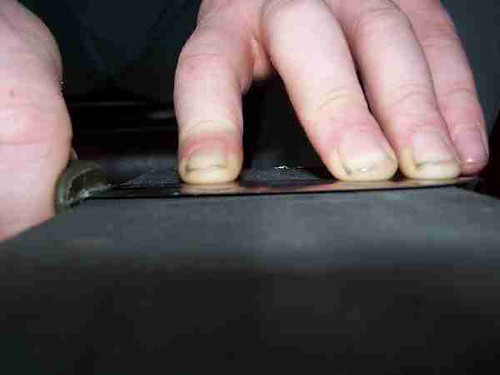
Step 3
Rock the knife blade towards the cutting edge so the bevel is flat to the board.
The angle should now be like this

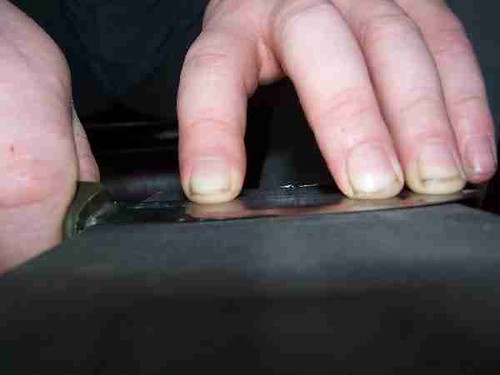
Step 4
Pushing the bevel flat to the board, push the knife away from you as though trying to shave off the tope atom of the paper.
You will find that the tip of the knife overhangs your board, and if you sharpen in a straight line, the tip gets no attention, so sharpen on a curve so that the tip is sharpened in the same stroke.
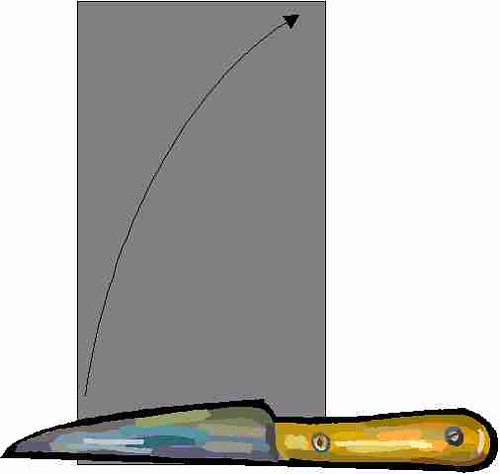
Lift the knife off the board, turn it over and, with the bevel facing towards you, shave in the opposite direction. Heres a picture.
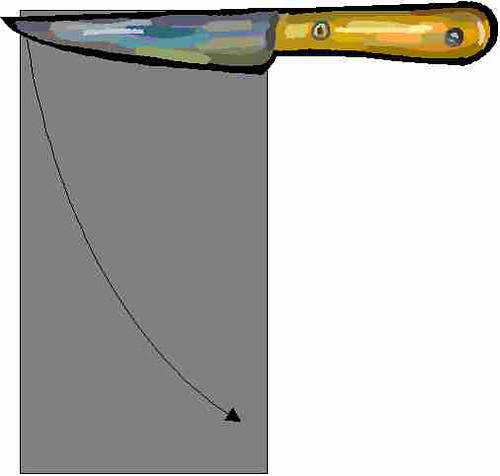
Note.
Never pull the knife towards you. In honing a knife, you are pulling the metal around. If you pull the knife, you built a soft burr or wire in front of the cutting edge. Magnified, it would look like this:
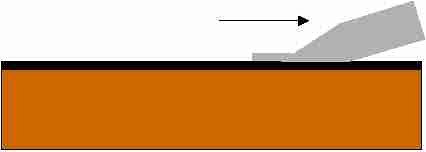
Step 5
How many passes (a pass is one shave each way)you will need depends on the steel of your knife and its condition. Try 50 passes to start with.
Step 6
Repeat steps 2 to 4 with your 400 grit board. This time you need 100 passes
Step 7
Repeat steps 2 to 4 with your 600 grit board. This time 150 passes.
Note
The exact number of passes will vary as stated a light re-touch can be achieved with just a few passes of your 600 grit.
Conclusion
By now, the bevel of your knife should look clean, unscratched and quite shiny. The purpose of the different grades is to create a smoother and smoother finish to the blade edge. With the coarse stone, you get the right angle, but the cutting edge is almost like a saw blade under a microscope. Each successive stone smoothes out the size of the teeth. We now have a knife that is sharp to a working edge. Holding a piece of paper in one hand, you should be able to slice it cleanly with the knife.
The blade is still not surgically sharp, and well look how to achieve that next.
Strop and steel
Now in the first stage of this process we have sharpened up a working edge. In this step we will polish it to shaving sharpness! This needs a strop and a steel.
Step 1
To strop a blade you need a soft and finely abrasive surface one of the best is a leather belt (use an old one). The leather belt works well because you can make a loop with the buckle and fasten it round a door handle, your foot, a branch etc. I tend to use rough side then smooth side.
I find that this action is improved by the application of a finely abrasive paste. I have heard of people using scouring cream, but I use .toothpaste! Weird, but it works. You may want to skip this if wearing the belt later!
So, form a loop and secure your strop. Pull tight with your left hand.
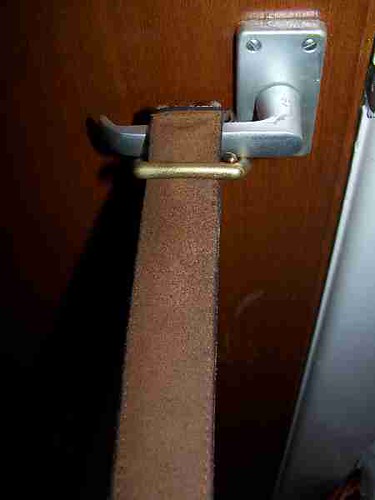
Now this time, you want to push the spine away from you with the bevel toward you and resting firmly on the leather (the other direction). It should go like this:
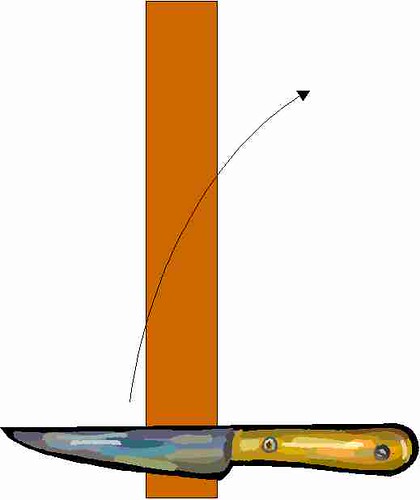
Then turn the knife over and drag the other side of the bevel towards you spine first like this.
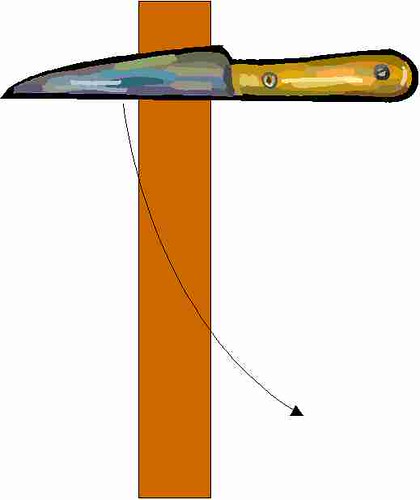
The purpose of this is to give the bevel the finest of polishes and to move the burr and possibly break it off the effect is shown below.

You will need to strop 200 times in each direction (more if you can this is hardly abrasive at all). You would of course do this with a razor strop if you had one, in the same way as you would use a water stone instead of the honing block.
Step 2
Finally we need to remove any remaining burr. This is achieved by Lightly running the bevel along a slightly rough surface. If you have a chefs steel in your carving set, thats fine. If not, use the edge of an old ceramic tile or even the lowered window of your car. Do it very lightly, no more than 6 times in each direction.
Now, you should be able to shave with your knife with a kit that cost a few quid!
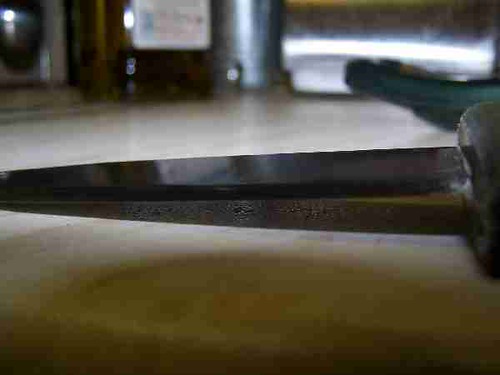
Hope thats interesting to someone!
Red
Great post and I've tried it many yrs ago the only flaw is the belt strop it's gonna convex yer edge
Last edited by a moderator:
Totally agree that set up works perfectly (its my everyday sharpening kit), it doesn’t quite meet the £5 part of the brief thoughDc4, o.8mm thick leather glued onto a piece of 1 inch ply and autosol metal polishing compound = razor sharpness, the reason for the thin leather as many people on here will know that thick leather will convex a flat bevel
It did back in 2006 when it was written 
Pound shops still sell some cheap wet and dry from time to time or B&M or home bargains as well. They are your friends when doing stuff like this.
With the longevity of this thread is does stand up to the test of time on how good an article it is. Many of us still use it.
Pound shops still sell some cheap wet and dry from time to time or B&M or home bargains as well. They are your friends when doing stuff like this.
With the longevity of this thread is does stand up to the test of time on how good an article it is. Many of us still use it.
It did back in 2006 when it was written
Pound shops still sell some cheap wet and dry from time to time or B&M or home bargains as well. They are your friends when doing stuff like this.
With the longevity of this thread is does stand up to the test of time on how good an article it is. Many of us still use it.
When was a DC4 ever less than a fiver?
I use 3M automotive fine finishing papers 600 - 1500 grits.
My strop is a length of office file folder with honing compound scribbled on it.
That is tapes ( not glued) to a granite counter top cut-off.
The mandrel for a Stubai 7/75 wood carver's adze is a tennis ball.
My strop is a length of office file folder with honing compound scribbled on it.
That is tapes ( not glued) to a granite counter top cut-off.
The mandrel for a Stubai 7/75 wood carver's adze is a tennis ball.
us a river stone and a tungsten carbide scraper, i can get cpm 3v to shaving sharp in 3 mins with them
If we ever cross paths, like if you come to the summer Moot, I would be very interested to see how that works.
Chris
Chris
I think that I know what George is doing.
There isn't one river stone in a thousand that's really good.
In almost 20 years here, I have found 2 stones that are sort of OK.
Here's a transcribed movie of Mungo Martin (Kwakwaka'Wakw).
He's largely responsible for sustaining PacNW art and carving during the dark ages of colonial cultural genocide.
Somewhere near the beginning you watch him sharpen his crooked knife with a river stone and a bucket of water.
There isn't one river stone in a thousand that's really good.
In almost 20 years here, I have found 2 stones that are sort of OK.
Here's a transcribed movie of Mungo Martin (Kwakwaka'Wakw).
He's largely responsible for sustaining PacNW art and carving during the dark ages of colonial cultural genocide.
Somewhere near the beginning you watch him sharpen his crooked knife with a river stone and a bucket of water.
its very simple but i will show you these 2 links that will explain how to do so better then i can, this how i learnt haven't touched my Japanese whetstones in 2 years.
for stone sharpening
for tungsten carbide sharpening and honing
https://www.sharpensbest.com/product-page/copy-of-sharp-n-spark-4-in-1-combo-sharpener-free-gift ------ I use this keep it clipped to my jeans belt loop super small and has my fire steel
https://www.sharpensbest.com/product-page/copy-of-sharp-n-spark-4-in-1-combo-sharpener-free-gift ------ I use this keep it clipped to my jeans belt loop super small and has my fire steel
Last edited:
Making your tools
Now, if you have £30-£40 to invest in a set of water stones, plus £20 for a razor strop and £20 for a great chef steel, you can get a razor edge on your knife. I do mean shaving sharp. But what if you havent? Well a friend of mine challenged me to get a beaten up Mora to shave for under five pounds. I do love a challenge!
I openly acknowledge that all the ideas shown here have been robbed from a variety of sources - not least Mors Kochanski, however a personal experience may be interesting (and the techiques do work) so heres how I went about it. Total cost to me? About £4 max.
You will need..
Three FLAT pieces of wood around 9 by 4. Actually anything very flat that you can cut to about that size is great tiles work well, thick glass is fantastic, sheet metal, whatever)
A pack of mixed grade wet & dry paper from the local DIY store (240, 400 & 600 grit or close)
A pair of scissors
A piece of old inner tube from your firelighting kit (or a bit of old leather or cork or anything non slip)
Some glue
Some double sided tape (carpet laying tape from the same DIY store is great)

Step 1
Cut your boards to size. They need to be the as long as the width of your wet&dry and about 4 wide. You will need 3 of them
Step 2
Cut a piece of your first wet&dry to fit your board

Step 3
Cover the flattest side of the board in double-sided tape

Step 4
Stick the wet&dry onto the tape. Turn over and press flat

Step 5
Cut up a bit of inner tube to make non slip feet for your board. Glue into place. Using a permanent marker, write the grit size on your board.

Step 6
Repeat for the other grit sizes
You now have a matched set of 3 sharpening boards!

Basic Honing
Now, looking at the knife Im teaching you to sharpen (A Frost Mora), you will notice that it only has a primary grind, and no secondary bevel. This makes it a great bush knife as sharpening is relatively simple even in the field.
So, lets get a working edge.
Step 1
Examine the cutting edge. Are there any nicks or dings in the edge? If so, we need to get rid of them. We do this by placing a metal file flat to the bevel and filing the bevel, for the full length of the blade. Use five strokes on one side followed by five on the other. As the ding disappears, reduce the number until you are alternating sides. As soon as you have a nice straight edge, stop.
Step 2
Take your 240 grit sharpening board. You dont need to wet it. Lay the flat side of the knife flat on the board. Hold the handle of the knife in your right hand and push the hilt up to the board. Using your left hand, spread your fingers and brace the blade evenly across the board.
Here is the angle

Here is what it looks like

Step 3
Rock the knife blade towards the cutting edge so the bevel is flat to the board.
The angle should now be like this


Step 4
Pushing the bevel flat to the board, push the knife away from you as though trying to shave off the tope atom of the paper.
You will find that the tip of the knife overhangs your board, and if you sharpen in a straight line, the tip gets no attention, so sharpen on a curve so that the tip is sharpened in the same stroke.

Lift the knife off the board, turn it over and, with the bevel facing towards you, shave in the opposite direction. Heres a picture.

Note.
Never pull the knife towards you. In honing a knife, you are pulling the metal around. If you pull the knife, you built a soft burr or wire in front of the cutting edge. Magnified, it would look like this:

Step 5
How many passes (a pass is one shave each way)you will need depends on the steel of your knife and its condition. Try 50 passes to start with.
Step 6
Repeat steps 2 to 4 with your 400 grit board. This time you need 100 passes
Step 7
Repeat steps 2 to 4 with your 600 grit board. This time 150 passes.
Note
The exact number of passes will vary as stated a light re-touch can be achieved with just a few passes of your 600 grit.
Conclusion
By now, the bevel of your knife should look clean, unscratched and quite shiny. The purpose of the different grades is to create a smoother and smoother finish to the blade edge. With the coarse stone, you get the right angle, but the cutting edge is almost like a saw blade under a microscope. Each successive stone smoothes out the size of the teeth. We now have a knife that is sharp to a working edge. Holding a piece of paper in one hand, you should be able to slice it cleanly with the knife.
The blade is still not surgically sharp, and well look how to achieve that next.
Strop and steel
Now in the first stage of this process we have sharpened up a working edge. In this step we will polish it to shaving sharpness! This needs a strop and a steel.
Step 1
To strop a blade you need a soft and finely abrasive surface one of the best is a leather belt (use an old one). The leather belt works well because you can make a loop with the buckle and fasten it round a door handle, your foot, a branch etc. I tend to use rough side then smooth side.
I find that this action is improved by the application of a finely abrasive paste. I have heard of people using scouring cream, but I use.toothpaste! Weird, but it works. You may want to skip this if wearing the belt later!
So, form a loop and secure your strop. Pull tight with your left hand.

Now this time, you want to push the spine away from you with the bevel toward you and resting firmly on the leather (the other direction). It should go like this:

Then turn the knife over and drag the other side of the bevel towards you spine first like this.

The purpose of this is to give the bevel the finest of polishes and to move the burr and possibly break it off the effect is shown below.

You will need to strop 200 times in each direction (more if you can this is hardly abrasive at all). You would of course do this with a razor strop if you had one, in the same way as you would use a water stone instead of the honing block.
Step 2
Finally we need to remove any remaining burr. This is achieved by Lightly running the bevel along a slightly rough surface. If you have a chefs steel in your carving set, thats fine. If not, use the edge of an old ceramic tile or even the lowered window of your car. Do it very lightly, no more than 6 times in each direction.
Now, you should be able to shave with your knife with a kit that cost a few quid!

Hope thats interesting to someone!
Red
Now, if you have £30-£40 to invest in a set of water stones, plus £20 for a razor strop and £20 for a great chef steel, you can get a razor edge on your knife.
You must be psychic !
Kudos to you Sir and thank you
Similar threads
- Replies
- 0
- Views
- 288
